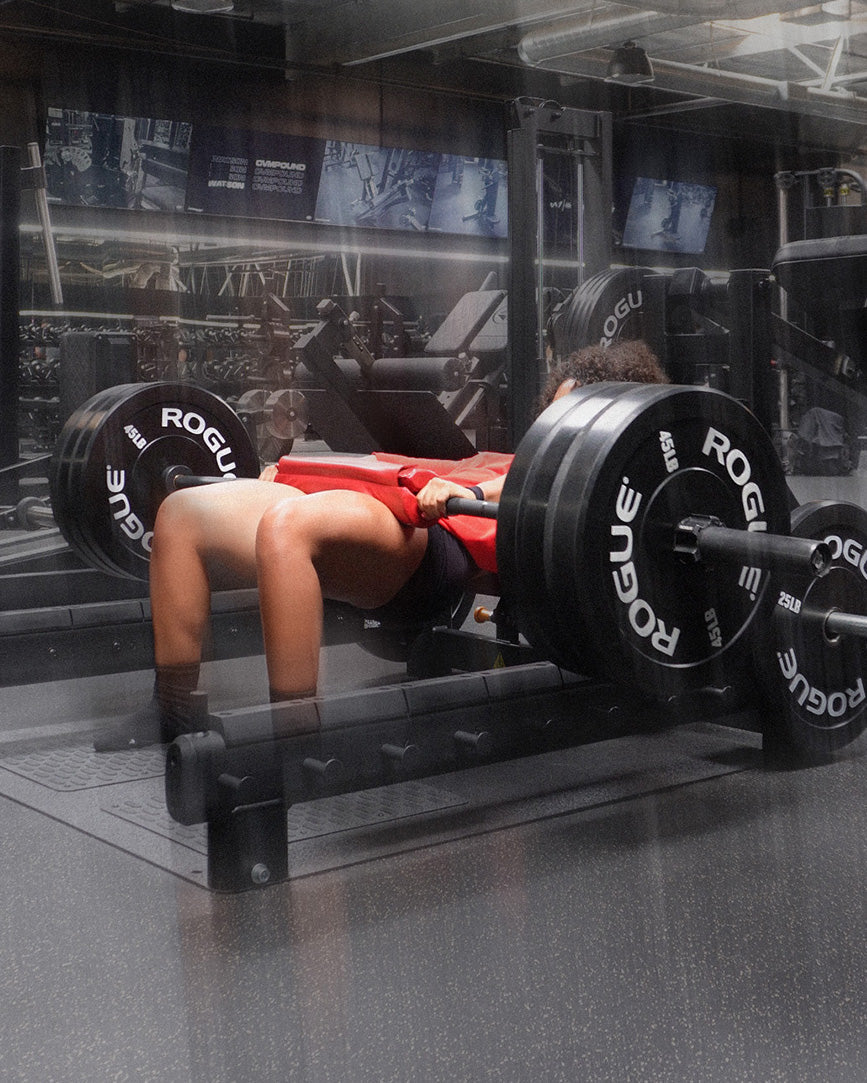A common fitness goal, especially for women, is building stronger, rounder glutes. While squats often get all the hype, when it comes to glute isolation, hip thrusts and glute bridges are the real MVPs. That doesn’t mean you should ditch squats altogether, but adding these two movements to leg day can transform your glute gains and strengthen your entire posterior chain.
To beginners, the hip thrust vs glute bridge debate can feel confusing since the exercises look so similar. Both involve driving your hips upward and squeezing at the top. But there are important differences that affect how much they target your glutes, when you should use them, and how you can progress over time.
Below, we’ll break down hip thrust vs glute bridge, including the key differences, how to perform each with proper form, and when to add them to your training routine.
Hip Thrust vs Glute Bridge: What’s the Difference?
Both the hip thrust and glute bridge engage the glutes, hamstrings, core, and hip flexors. The difference comes down to setup, range of motion, and progression potential.
Glute Bridge:
- Performed lying flat on the floor.
- Smaller range of motion.
- Easy, beginner-friendly, and requires minimal equipment.
- Harder to progressively overload (adding weight is limited).
- Performed with your upper back on a bench or platform.
- Greater range of motion, allowing for full hip extension.
- More glute activation, especially under heavier loads.
- Easy to progress by adding a barbell, dumbbell, or kettlebell.
In short, the glute bridge is perfect for beginners, home workouts, and glute activation, while the hip thrust is better for heavy, progressive strength training.
How To Do A Glute Bridge
Glute bridges are simple, equipment-light, and effective. Here’s how to perform one with a resistance band:
How to do it:
- Wrap a short resistance band around your thighs, slightly above your knees. Lie on your back and bend your knees. Bring your heels close to the glutes, but not so much that they’re touching. Keep your feet hip-width apart with your arms flat on the mat.
- Engage your core so your back presses into the floor.
- Press your heels into the mat and lift your hips up toward the ceiling until they’re aligned with your knees. Squeeze your glutes at the top of the stretch, hold for a few seconds, and lower your hips back down. Make sure your shoulders and arms aren’t lifting off the mat.
Advanced variation: The single-leg glute bridge. Perform the same movement, but extend one leg toward the ceiling while keeping the other planted on the floor.
When To Do Glute Bridges
Glute bridges are best for:
- Glute activation: Use them as a warm-up before squats, deadlifts, or hip thrusts.
- Active recovery: Low-impact and joint-friendly, they’re perfect for recovery days.
- Home workouts: No bench? No problem. Bodyweight, bands, or a dumbbell across your hips can make them challenging enough.
How To Do A Hip Thrust
For maximum glute growth, the barbell hip thrust is king. Here’s how to nail your form:
How to do it:
- Load your barbell and wrap a barbell pad around the bar for comfort. Place your back against the bench, making sure that only your shoulder blades and upper back are touching it. Plant your feet flat on the ground a few inches ahead of you and roughly shoulder-width apart.
- We suggest having a spotter place the barbell comfortably and safely on your hips, but if you're alone, then roll the barbell into the crease of your hips. Just be careful when doing this.
- Make sure that your back is neutral and flat, brace your core, and squeeze your glutes. Before you push the bar up, maintain a forward gaze with your neck slightly tucked into your chin. This will prevent lumbar hyperextension and an unwanted strain on your neck.
- Now, using your torso as a lever, push your hips up towards the ceiling driving through your heels until you form a straight line from your knees to your shoulders. Lockout at the top of the movement and pause for a second or two.
- Begin to descend slowly back to the starting position before bracing for your next rep.
Beginner tip: Start with a dumbbell across your hips before progressing to a barbell.
When To Do Hip Thrusts
Since hip thrusts are heavy and challenging, they’re best performed early in your lower-body workout when you’re fresh.
They’re ideal for:
- Advanced lifters ready to load heavy.
- Building maximum glute strength and size.
- Gym sessions where you have access to a bench and barbell.
Skip them as a warm-up—stick to glute bridges for activation.
Hip Thrust vs Glute Bridge: Which Should You Do?
The best choice depends on your goals, equipment, and experience level.
-
Choose Glute Bridges if…
You’re new to training, working out at home, or looking for activation drills and recovery work. -
Choose Hip Thrusts if…
You’re experienced, want to lift heavy, and are focused on maximizing glute strength and size.
But don’t think of it as hip thrust vs glute bridge—both belong in your routine. Use glute bridges for warm-ups, activation, or lighter training days, and use hip thrusts as your go-to heavy hitter for glute growth.
Level Up With the Right Gear
Whether you’re doing glute bridges or hip thrusts, the right gear makes all the difference. Grab UPPPER Barbell Pads for both glute bridges and hip thrusts to lift heavy without discomfort.
Find what your gym bag is missing with UPPPER—durable, stylish, and built to keep up with every rep.

